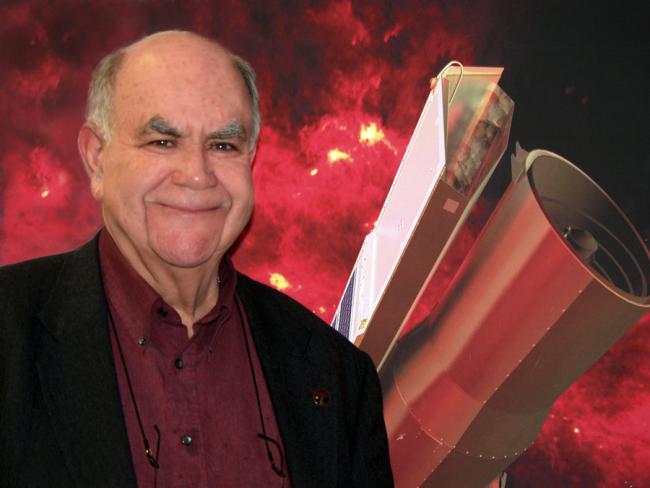Giovanni Fazio Receives 2008 Royal Society of London/COSPAR Massey Award

Image of Giovanni Fazio.
The Smithsonian Astrophysical Observatory is pleased to announce that Dr. Giovanni Fazio will receive the 2008 Royal Society of London/COSPAR Massey award for outstanding contributions to space science. The award will be presented at the COSPAR Scientific Assembly in Montreal, Canada, in July.
The Award honors the memory of Sir Harrie Massey, FRS, past Physical Secretary of the Society and past member of the COSPAR Bureau. The award consists of a gold medal and a prize of 500 guineas. This award recognizes outstanding contributions to the development of space research, interpreted in the widest sense, in which a leadership role is of particular importance.
Dr. Fazio is presently Senior Physicist, Harvard-Smithsonian Center for Astrophysics; Lecturer, Astronomy Department, Harvard University; and a Faculty Member, International Space University, Strasbourg, France. He received BS (Physics) and BA (Chemistry) degrees from St. Mary¹s University, Texas, in 1954, and a Ph.D. (Physics) from the Massachusetts Institute of Technology in 1959, having done his graduate work in elementary particle physics. The same year, he joined the Physics Department, University of Rochester, where he pioneered the development of gamma-ray astronomy using balloon-borne telescopes and was the Co-Principal Investigator for the gamma-ray detector experiment on NASA¹s first Orbiting Solar Observatory.
In 1962, Dr. Fazio joined the Smithsonian Astrophysical Observatory and the Harvard College Observatory, where he initiated a program in gamma-ray astronomy using balloon-borne and ground-based detectors. He also initiated the construction of the 10-meter optical reflector at the F. L. Whipple Observatory, Arizona, to search for ultrahigh-energy cosmic gamma-rays. In the early 1970¹s he pioneered the development of large balloon-borne telescopes for far-infrared astronomical observations above the atmosphere, and for twenty years was Principal Investigator for the 1-Meter Balloon-Borne Far-Infrared Telescope. He was also the Principal Investigator for the first infrared astronomical telescope to fly on the Spacelab II flight of the Space Shuttle.
In 1984 he was selected as Principal Investigator for the Infrared Array Camera (IRAC) experiment on the Spitzer Space Telescope, one of NASA¹s Great Observatories. The Spitzer Space Telescope was launched in August, 2003, and since then continues to produce spectacular new images of the infrared Universe.
Dr. Fazio was also a Co-Investigator on the Submillimeter Wave Astronomical Satellite (SWAS). His current research interests include the development of infrared instrumentation and the use of infrared array cameras on ground-based and space telescopes to observe galaxy formation and evolution in the early Universe, ultraluminous galaxies, star formation and evolution, and brown dwarfs.
Dr. Fazio is also past President of the International Astronomical Union¹s Division XI and Commission 44 (Space and High Energy Astrophysics); past Chairman, Universities Space Research Association (USRA) Science Council for Astronomy and Space Physics; and past Vice-Chairman of the COSPAR Commission on Research in Astrophysics from Space.
Dr. Fazio is a Fellow of the American Physical Society and past chairman of its Astrophysics Division, a Fellow of the American Association for the Advancement of Science (AAAS), a member of the American Astronomical Society and past chairman of its High Energy Astrophysics Division. He is also a member of the International Astronomical Union, the Optical Society of America, and a Fellow of the Royal Astronomical Society. He has been a member of numerous national and international advisory committees and is the author of more than 300 publications in scientific journals and books. In 2005, Dr. Fazio received the UNICO Natinal Marconi Science Award and Medal and the NASA Public Service Medal.
Further information on the award may be found at http://cosparhq.cnes.fr/Awards/awards.htm
SAO astronomer Gary Melnick has joined three colleagues in a new paper that successfully explains where the oxygen is likely to be located. The scientists developed models that include the effects of ultraviolet radiation from nearby stars on gas clouds, as well as the chemical combining of oxygen into CO gas, and the effects of oxygen freezing onto dust grains where it can be converted into water ice. Their calculations show that water ice is much more abundant than had been realized - it sharply increases in abundance a short distance into a cloud, once the ultraviolet radiation can be shielded. The oxygen that has so far gone undetected can plausibly be contained in this water ice, at least in the specific cases which they investigate. The results are a landmark in advancing our understanding of interstellar chemistry, and in explaining the mysterious apparent absence of oxygen.
In the News
The New York Times (6 January 2009) featured SAO astronomer Mark Reid's new conclusions on our Milky Way galaxy. Using radio interferometry techniques, he discovered that it is about 50% more massive than we had previously realized. The same NYT article also cites SAO astronomer Elizabeth Humphreys and her discovery of two new young stars close to the black hole at the galaxy's center. Reid's discovery was also featured on The Colbert Show on Comedy Central.
This week's issue of the journal Science highlights the International Year of Astronomy, and features on its cover a spectacular infrared image of the center of our Milky Way galaxy. SAO astronomer Howard Smith was a member of the team that obtained and published the original image, which was taken with the Infrared Array Camera, an instrument whose team is led by SAO astronomer Giovanni Fazio.